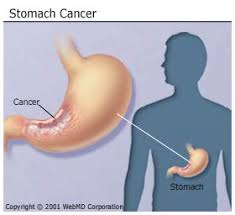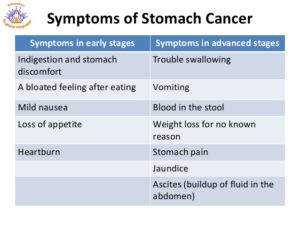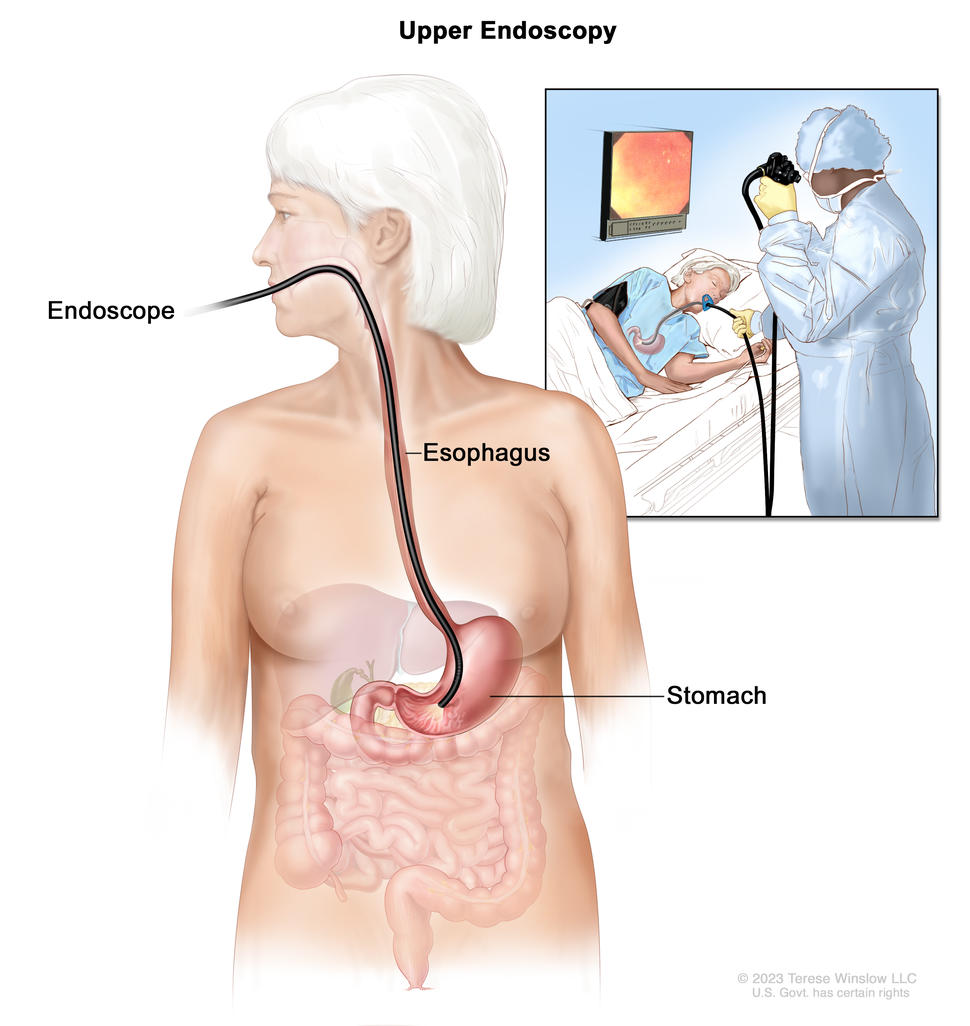What is stomach cancer?
Stomach cancer (also called gastric cancer) can develop in any part of the stomach, and may spread throughout the stomach and to other organs. It may grow along the stomach wall into the esophagus or small intestine.
The cancer may also extend through the stomach wall and spread to nearby lymph nodes and organs, such as the liver, pancreas and colon. It may spread to distant organs, such as the lungs, the lymph nodes above the collarbone and to a woman’s ovaries.
Different types of stomach cancer include:
- Adenocarcinomas develop within the cells of the innermost lining of the stomach. The majority of stomach cancers are classified as adenocarcinomas.
- Lymphoma is a cancer of the immune system tissue that may start anywhere there are lymph tissues, including the stomach. Lymphomas in the stomach are rather rare and only account for about 4 percent of all stomach cancers.
- Gastrointestinal stromal tumors, or GISTs, are a rare type of stomach cancer that starts in a special cell found in the lining of the stomach called interstitial cells of Cajal (ICCs). Under a microscope, GIST cells look similar to muscle or nerve cells. These tumors may develop throughout the digestive tract, but about 60 to 70 percent occur in the stomach.
- Carcinoid tumors typically start in the hormone producing cells of the stomach. These tumors usually do not spread to different organs and account for only about 3 percent of stomach cancer incidence.
RISK FACTORS FOR STOMACH CANCER:
GENERAL
- Age: Stomach cancer is found most often in people over age 55.
- Gender: The disease affects men twice as often as women.
- Race: Stomach cancer is more common in African Americans than in Caucasians.
- Region: This type of cancer is more common in some parts of the world, such as Japan, Korea, parts of Eastern Europe and Latin America. People in these areas eat many foods that are preserved by drying, smoking, salting or pickling.
BODY
- Obesity: Obesity has been linked to an increased risk of stomach cancer
GENETICS
Certain gene mutations and some inherited conditions are considered stomach cancer risk factors. They include:
- BRCA1 & BRCA2: Inherited mutations on the BRCA1 and BRCA2 genes are often associated with higher risks for breast cancer. Individuals who have inherited these genetic mutations are also at an increased risk for stomach cancer
- E-cadherin/CDH1: Though rare, people who inherit this genetic mutation have a 70 to 80 percent chance of developing stomach cancer in their lifetime. Also, women with this genetic defect have an increased risk of breast cancer.
- Lynch syndrome: This condition may also be referred to as hereditary non-polyposis colorectal cancer (HNPCC), a genetic condition that runs in families. More commonly, this condition is associated with an increased risk for colon cancer. HNPCC also predisposes people to stomach cancers.
- Familial adenomatous polyposis (FAP): This syndrome causes polyps in the colon, stomach and intestines. Often caused by mutations of the gene APC, this syndrome greatly increases a person’s risk of colorectal cancer and may play a small role in increasing a person’s stomach cancer risk.
LIFESTYLE
- Smoking: There is evidence linking cigarette smoking to many types of cancer, including stomach cancer. Smokers have been found to be at greater risk of developing cancer than non-smokers.
- Diet: Scientists believe that eating foods preserved in these ways may play a role in the development of stomach cancer. On the other hand, fresh foods (especially fresh fruits and vegetables and properly frozen or refrigerated fresh foods) may protect against this disease.
- Working in the coal, metal or rubber industries: Chemicals that are released in these environments have been linked to the development of stomach cancer.
OTHER CONDITIONS
- H. pylori infection: Doctors have found that a long-term H. pylori infection may lead to inflammation and pre-cancerous changes to the stomach lining. In fact, stomach cancer patients typically have a higher incidence of H. pylori infections than people who do not have stomach cancer.
- Pernicious anemia: Some people with pernicious anemia may have gastric polyps, which can increase the risk of stomach cancer.
- Epstein-Barr virus infection: According to the American Cancer Society, Epstein-Barr virus is found in the cancer cells of about 5% to 10% of people with stomach cancer.
How its diagnosed:
If you have symptoms that suggest stomach cancer, your doctor will need to find out if they’re due to cancer or another condition. They may
- ask about your personal and family medical history to learn about your possible risk factors for stomach cancer
- do a physical exam, which will include feeling your abdomen for anything abnormal
- run blood tests to check for anemia (a low red blood cell count), which could be a sign of bleeding in the stomach
- check your stool for hidden (occult) blood, which could be a sign of bleeding in the stomach
Depending on these results, your doctor may recommend tests to find out if you have stomach cancer.
Tests to diagnosis stomach cancer:
Upper endoscopy with biopsy
Upper endoscopy is a procedure to look inside the esophagus, stomach, and duodenum (first part of the small intestine) to check for abnormal areas. An endoscope (a thin, lighted tube) is passed through the mouth and down the throat into the esophagus. It may also have a tool to remove a sample of cells or tissue (biopsy) so a pathologist can view it under a microscope to check for signs of cancer.
The sample of tissue may be checked for Helicobacter pylori (H. pylori) infection and used for biomarker testing.
Talk with your doctor to learn what to expect during and after your biopsy.
To learn about the type of information that can be found in a pathologist’s report about the cells or tissue removed during a biopsy, see Pathology Reports.
Barium swallow
Barium swallow is a series of x-rays of the esophagus and stomach. The patient drinks a liquid that contains barium (a silver-white metallic compound). The liquid coats the esophagus and stomach, and x-rays are taken. This procedure is also called an upper GI series.
CT (CAT) scan
A CT scan uses a computer linked to an x-ray machine to make a series of detailed pictures of areas inside the body from different angles. A dye may be injected into a vein or swallowed to help the organs or tissues show up more clearly.
Biomarker testing
Biomarker testing is a way to look for genes, proteins, and other substances (called biomarkers or tumor markers) that can provide information about cancer. Some biomarkers affect how certain cancer treatments work. Biomarker testing may help you and your doctor choose a cancer treatment for you.
For stomach cancer, biomarker testing includes the following:
- HER2: The cancer cells may have larger than normal amounts of a protein called HER2.
- PD-L1: The cells may have larger than normal amounts of an immune checkpoint protein called PD-L1.
- Microsatellite instability: The cells may have microsatellite instability. This may be caused by mistakes that don’t get corrected when DNA is copied in a cell.
- Mismatch repair deficiency: The cells may have a defect in a mismatch repair gene.
- Tumor mutational burden: If the cells have a high tumor mutational burden, it means they have many gene mutations.
- NTRK: The cells may have changes in one of the NTRK genes.
TESTS TO STAGE STOMACH CANCER:
If you’re diagnosed with stomach cancer, you will be referred to a gastrointestinal oncologist. This is a doctor who specializes in diagnosing and treating cancers of the stomach and intestines. Your doctor will recommend tests to find out if the cancer has spread and if so, how far. Sometimes the cancer is only in the stomach. Or, it may have spread from the stomach to other parts of the body. The process of learning the extent of cancer in the body is called staging. It is important to know the stage of the stomach cancer to plan treatment.
The following imaging tests and procedures may be used to find out your stage:
- Endoscopic ultrasound is a procedure in which an endoscope is inserted into the body, usually through the mouth or rectum. An endoscope is a thin, tube-like instrument with a light and a lens for viewing. A probe at the end of the endoscope is used to bounce high-energy sound waves (ultrasound) off internal tissues or organs and make echoes. The echoes form a picture of body tissues called a sonogram. This procedure is also called endosonography.
- PET-CT scan combines the pictures from a positron emission tomography (PET) scan and a computed tomography (CT) scan. The PET and CT scans are done at the same time on the same machine. The pictures from both scans are combined to make a more detailed picture than either test would make by itself.
- For the PET scan, a small amount of radioactive glucose is injected into a vein. The scanner rotates around the body and makes a picture of where glucose is being used in the body. Cancer cells show up brighter in the picture because they are more active and take up more glucose than normal cells.
- For the CT scan, a series of detailed x-ray pictures of areas inside the body is taken from different angles. A dye may be injected into a vein or swallowed to help the organs or tissues show up more clearly.
- Magnetic resonance imaging (MRI) with gadolinium is a procedure that uses a magnet, radio waves, and a computer to make a series of detailed pictures of areas inside the body. A substance called gadolinium is injected into a vein. The gadolinium collects around the cancer cells so they show up brighter in the picture. This procedure is also called nuclear magnetic resonance imaging (NMRI).
- Laparoscopy is a surgical procedure to look at the organs inside the abdomen to check for signs of disease. Small incisions (cuts) are made in the wall of the abdomen and a laparoscope (a thin, lighted tube) is inserted into one of the incisions. Other instruments may be inserted through the same or other incisions to perform procedures such as removing organs or taking tissue samples to be checked under a microscope for signs of cancer. A solution may be washed over the surface of the organs in the abdomen and then removed to collect cells. These cells are also looked at under a microscope to check for signs of cancer.
Treatment for stomach cancer:
Surgery (gastrectomy) is the most common treatment approach, especially when the illness is at an early stage. For many people with gastric cancer, minimally invasive surgical techniques provide the best option since they tend to lead to fewer complications, shorter recovery times, less need for pain relief, and reduced risk that the cancer will return compared with open surgeries. The surgeons at Memorial Sloan Kettering are global leaders in this area, having performed more laparoscopic stomach procedures than any other cancer center in the country.
For more advanced stomach cancer, your care team may recommend treatments in addition to surgery, such as chemotherapy, radiation therapy, or a combination of these approaches. These therapies may help you live longer and experience fewer symptoms.


